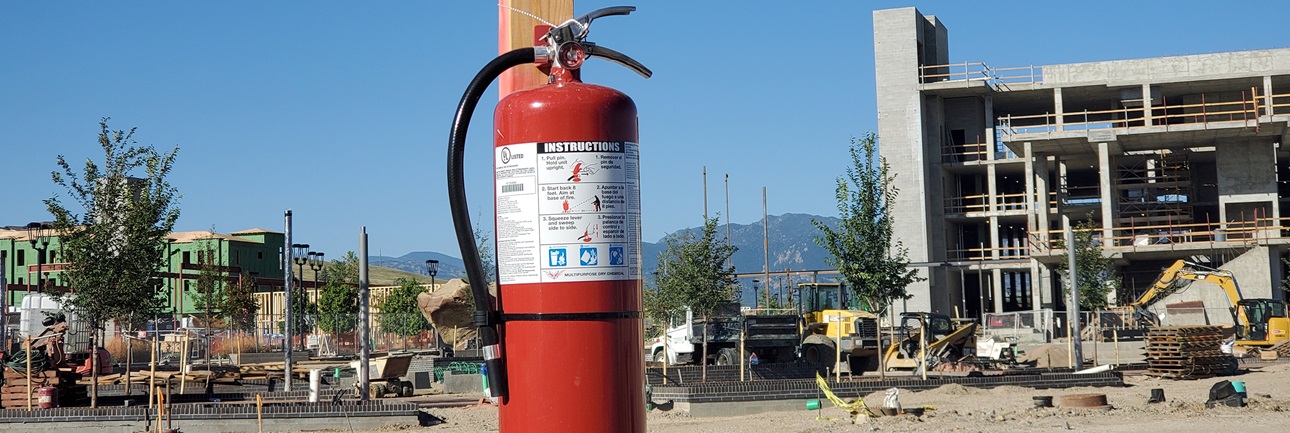There is no doubt that workplace fires can result in serious property damage, injuries and even death. Fires are more common on residential construction jobsites than many builders think. Working with hazardous materials, using temporary heating devices, and performing hot work can lead to dangerous and costly fires.
Which OSHA Standards Address Fire Protection and Prevention in Construction?
29 CFR Part 1926, Subpart F, contains general fire protection and prevention requirements for construction work.
Fire Protection and Prevention Program
Employers are responsible for the development and maintenance of an effective fire protection and prevention program at the jobsite throughout all phases of the construction, repair, alteration or demolition work. The employer must ensure the availability of fire protection and suppression equipment as required by Subpart F. The procedures to implement a program include:
- Providing at least one 2A (or better) fire extinguisher for each house under construction
- Keeping access to fire extinguishers clear
- Training workers how to operate fire extinguishers
- Inspecting fire extinguishers periodically
- Developing a system to notify employees of a fire onsite
- Posting fire notification procedures where employees can find them if needed
Training Requirements
Portable fire extinguishers must be inspected periodically and maintained in accordance with Maintenance and Use of Portable Fire Extinguishers, NFPA No.10A-1970.
Potential Ignition Sources
The residential construction industry works with a variety of materials and products that are potential ignition sources. Be sure workers know what materials are flammable and what precautions they need to take to avoid fires on the jobsite. Materials likely to be fire hazards include, gasoline, “liquid nails” or similar adhesives, oils, paints, solvents (cleaners), kerosene, paint stripper, sealants and pipe joint compound.
Firefighting Essentials
Should You Fight a Fire?
Before you begin to fight a fire:
- Make sure the fire department has been called.
- Your safety comes first. If your instincts tell you no, wait for the fire department to handle it.
- Be sure that everyone has left or is leaving the structure.
- Make sure the fire is confined to a small area and is not spreading.
- Be sure that you have an unobstructed escape route.
- Be sure that you know how to properly use the fire extinguisher.
Using a Fire Extinguisher
- Pull the Pin
- Aim the Nozzle at the Base of the Fire
- Squeeze the Trigger
- Sweep the Nozzle from Side to Side
Safe Work Practices
- Know where the fire extinguishers are and how to use them.
- Keep the fire extinguishers easy to see and in reach for an emergency.
- Keep fire extinguishers with a rating of at least 2A within 100 feet of storage areas.
- Use only approved safety cans for storing more than one gallon of flammable liquid, although the original container may be used for less than one gallon.
- Don’t store combustible materials more than 20-feet high.
- Keep areas clean of debris, weeds and grass.
- Store flammable liquids in closed containers when not in use.
- Keep temporary heaters at least six feet from any liquid petroleum gas container.
- Don’t store liquid petroleum gas tanks inside buildings.
- Use flammable liquids only where there are no open flames or other ignition sources within 50 feet of the operation.
For hot work (i.e., welding and cutting)
- Perform hot work in a safe location, or with fire hazards removed or covered, when practical.
- Use guards to confine the heat, sparks and slag, and to protect the immovable fire hazards.
- Do not perform hot work where flammable paints are present or where other flammable vapors or combustible materials exist. Relocate work or equipment outside of the hazardous areas, if possible.
- Make portable fire extinguishers immediately available.
- Assign additional personnel (i.e., a fire watch) to guard against fire while hot work is being performed or whenever welding or cutting is performed in locations where anything greater than a minor fire might develop.
- Maintain the fire watch for a sufficient period of time (typically, at least a half-hour) after completion of the work to ensure that no possibility of fire exists.
Fire Prevention and Protection Resources
- Fire Protection and Prevention Toolkit from the American Wood Council
- OSHA 29 CFR Part 1926, Subpart F – Fire Protection and Prevention
- OSHA 29 CFR Part 1926.352, Subpart J – Welding and Cutting, Fire Prevention
- OSHA Fire Safety Reference Material





